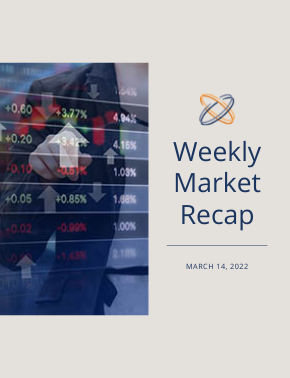Week in Review
Equity Markets:
All major indices ended the week down after a strong attempt to rally midweek. The S&P was down 2.69% despite Wednesday’s rally. The intraweek swing came on news that the Ukraine and Russia negotiations appeared productive, according to Russian President Vladimir Putin. This marks the fourth week out of five the S&P has been negative. The momentum built on Wednesday was short-lived and the markets gave back the majority of those gains in the latter half of the week as tensions only increased in Ukraine.
Volatility remained high as we saw large intraday swings. Tuesday, the S&P continued a downward swing early before a mid-day rally. The S&P saw over a 2.5% upward move from the lows of the day before ending the day in the red.
As the end of the first quarter nears, the market has struggled to gain traction despite solid earnings numbers and generally positive economic news. Focus has shifted on the future impact of both economic growth and earnings expectations for the remainder of 2022. Inflation has been a concern for a full year now, and the concern appears to continue going forward. According to FactSet, 356 of the S&P 500 companies referenced inflation in their most recent earnings calls. Corporate profit margins have been near historic highs, but many companies have expectations for slight profit margin compression in Q1, with 12.2% versus 12.4% expected, according to FactSet.
Fixed Income Markets:
The fixed income markets also saw downward pressure as bond prices retreated, causing bond yields to jump over 11%. The 10-yr treasury ended the week at 1.99% after starting the week at 1.78%. The 2’s/10’s spread remained at ~0.25%. This spread has continued to narrow over the past 12 months. Bond market investors continue to reconcile the two major market forces of the war in Ukraine and the Fed’s new tightening cycle. Concerns have increased over the inflationary impacts of the war and how the Fed will handle policy.
Economic:
The February CPI was the headline economic report of the week. The CPI saw a 7.9% year-over-year increase, the highest in 40 years. Core CPI, which excludes food and energy, saw a year-over-year increase of 7.5%. Core CPI is seen to be a more stable reading due to the volatility in the food and energy markets.
The University of Michigan Consumer Sentiment Index declined to 59.7 versus the expected decline to 61. This marks the lowest level since 2011.
Looking Ahead
Equity Markets:
The markets will likely experience continued volatility this week as the two major influences in the market will collide. The uncertainty around Fed action will alleviate as the FOMC makes their newest policy decision. The conflict in Ukraine also remains important as we monitor developments and potential spillover effects.
Q1 2022 earnings season will go into full swing in a few weeks. As anticipated, earnings growth should see a meaningful decline. Estimates are 4.8%; which may seem like a disappointment when compared to earnings growth for 2021.It is important to remember the low levels last year’s growth rates were compared to. For the majority of 2020, the global economy grinded to a halt. In addition, there was a historical amount of liquidity in the market and pent-up consumer demand, which both still remain historically strong. Most market analysts anticipated a swift rebound from the deep pandemic lows and a leveling out process going forward.
Fixed Income Markets:
All eyes will be on the FOMC policy meeting set for this week. The results of the meeting will likely have major impacts on both the equity and fixed income markets. Most are eager to hear the Fed’s stance on what impacts the war in Ukraine will have on the US economy, specifically the already high inflationary pressures.
The expectation is for the Fed to increase the federal funds rate, the base rate banks charge for overnight lending and borrowing, by 0.25%. The current level is 0-0.25%, which was lowered at the start of the pandemic in March 2020. For reference, the Fed did not increase their target rate for nearly 7 years after the Great Financial Crisis.
Economic:
Along with the FOMC policy meeting, the February inflation picture will become clearer with the release of the Producer Price Index (PPI) and the Import Price Index. We also see a few data points around housing activity for February. So far, the conflict between Russia and Ukraine has not been represented in economic reports. This will change next week with the release of regional manufacturing reports from New York and Philadelphia.
Important Disclosures:
Investment Advisory Services offered through Krilogy®, an SEC Registered Investment Advisor. Please review all prospectuses and Krilogy’s Form ADV 2A carefully prior to investing. This is neither an offer to sell nor a solicitation of an offer to buy the securities described herein. An offering is made only by a prospectus to individuals who meet minimum suitability requirements.
All expressions of opinion are subject to change. This information is distributed for educational purposes only, and it is not to be construed as an offer, solicitation, recommendation, or endorsement of any particular security, products, or services.
Diversification does not eliminate the risk of market loss. Investments involve risk and unless otherwise stated, are not guaranteed. Investors should understand the risks involved of owning investments, including interest rate risk, credit risk and market risk. Investment risks include loss of principal and fluctuating value. There is no guarantee an investing strategy will be successful. Past performance is not a guarantee of future results. Indices are not available for direct investment; therefore, their performance does not reflect the expenses associated with the management of an actual portfolio. The S&P data is provided by Standard & Poor’s Index Services Group.
Services and products offered through Krilogy® are not insured and may lose value. Be sure to first consult with a qualified financial advisor and/or tax professional before implementing any strategy discussed herein.




















